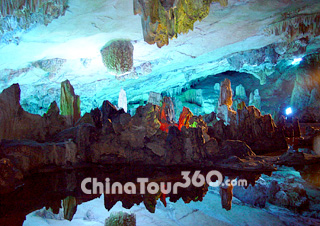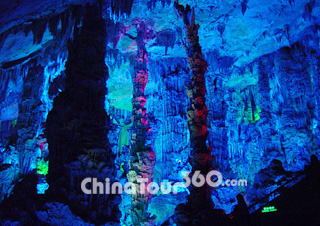 Guilin Reed Flute Cave
Guilin Reed Flute Cave Inside Reed Flute Cave
Inside Reed Flute Cave Stalactites in Reed Flute Cave
Stalactites in Reed Flute Cave
It is widely acknowledged that Guilin landscape tops that elsewhere under heaven. As one of the numerous natural caves in Guilin, Reed Flute Cave is the most noteworthy and renowned one that cannot be missed for any comers here. It is located five kilometers (3 miles) northwest of the downtown of Guilin, on the southern shoulder of the Guangming Hill (Bright Hill), in China.
The Bright Hill where Reed Flute Cave lies was originally called Maomaotou Hill. It is said that there used to be a small hole halfway on the hillside. The reed grass grew lushly on the hill, which can be made into flute with melodious sound. Hence, the name of the cave was derived.
The cave is about 240 meters (262.5 yards) long and it was formed 600,000 years ago. According to the geological research, the cave used to be an underground lake; it gradually turned into the cave as a result of the enhancement of the mountain and decline of the water level. In the long course, the calcium carbonate in the rock was dissolved by the underground water. When the water flew into the mouth of the cave through the gaps, the crystallization of the calcium carbonate was deposited. After the accumulation of several million years, the wonderful sceneries were formed.
When you enter the Reed Flute Cave, your eyes will be feasted with a large display of stone formations, such as stalactites, stalagmites, stone pillars, stone flowers, stone curtains, stone mushroom and so forth. If you look at each one with your imagination, you will surprisingly find every stone has its equivalence in the real life. Some are like the human figures, some resemble the animals, some are similar to the famous flowers, and some look like the fruit and vegetables. What is more, pagodas, forest, fish, waterfall, canyon, peanut, carrot are all available here. Even the artists and craftsmen dare not to say they outmatch the nature in making the fine works of art. It is no wonder Reed Flute Cave is reputed as 'The Palace of the Natural Arts'.
Tourist attractions in China are often associated with the legendary stories or names. It is quite fun to listen to the romantic stories while appreciating the nice scenery. Large amounts of the queer stones formations make up of the nice divisions such as Crystal Palace, Dragon Pagoda, and Virgin Forest, Flower and Fruit Mountain and other interesting ones.
According to the Chinese famous novel 'Journey to the West', the Dragon King's magic needle that Monkey King used as the weapon was actually the stone pillar in the cave. Taken the advantage of being covered by the verdant reed in lushness at the entrance of the cave, it was used as a hideout for many centuries by the people in the nearby area. During World War II and Anti-Japanese War, the cave served as a war refuge for lots of people. Newspaper, hospitals, printing companies all settled in the karst caves.
Opened to the public in 1962, there were actually visits of the cave in Tang Dynasty (618 - 907). The inscriptions on the wall have been existed since then. Reed Flute Cave is much more charming if put your imagination and vision together.
![]() Entrance Fee: CNY 90 (adults); CNY 45 (kids between 1.0 - 1.4 m); kids under 1.0 m are free of charge
Entrance Fee: CNY 90 (adults); CNY 45 (kids between 1.0 - 1.4 m); kids under 1.0 m are free of charge
![]() Opening Hours: 07:30 - 18:00 (Apr. to Oct.); 08:00 - 17:30 (Nov. to Mar.)
Opening Hours: 07:30 - 18:00 (Apr. to Oct.); 08:00 - 17:30 (Nov. to Mar.)
![]() Bus Routes:Take Bus No. 3 or 58 and get off at Reed Flute Cave stop.
Bus Routes:Take Bus No. 3 or 58 and get off at Reed Flute Cave stop.
![]() Recommended Visiting Time: 40 minutes
Recommended Visiting Time: 40 minutes







